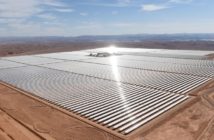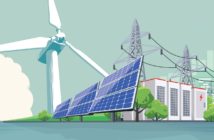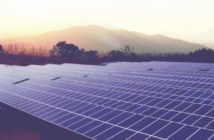Morocco imports 95% of its energy. Its fortunes dependent on oil-price fluctuations, the country’s trade deficit has been expanding.
Renewable energy was an obvious solution for a country that has more than 2,000 miles of windy coasts along the Atlantic Ocean and the Mediterranean Sea and more than 3,000 hours of sunshine annually; it also has access to the biggest sand desert on the planet.
With energy plants under construction that will generate solar, wind and hydro power on a scale never before seen in Africa, Morocco is turning very green. By 2020, the country plans to generate over 40% of its energy from renewables. Already, construction is under way at the northern edge of the Sahara on a solar plant that will eclipse by 60 MW the world’s current largest solar facility—a 100-MW concentrated solar power (CSP) plant opened in March in Abu Dhabi.
Morocco launched a concerted fund-raising and development effort in 2009 to boost capacity in all three renewables, and the projects are now starting construction.
The first phase of Morocco’s expansive solar power program is the 160-MW, $660-million CSP plant at the foothills of the Atlas Mountains near the southern city of Ourzazate. The plant will use a parabolic trough, a three-hour thermal storage system and wet-cooling technology. Last year, MASEN started construction on the main roads, an 8-million-gallon water reservoir and connections to a dam 2.5 miles away from the site. Meanwhile, Morocco’s utility company, ONEE, is building electric, 500-MW-capacity substations and laying high-voltage lines. Led by Saudi Arabia’s Acwa Power—which won the bid last summer— construction will start on the plant itself at the end of May.
The EPC contract for constructing and putting the plant on line went to an all-Spanish consortium of Acciona, SENER and TSK. The plant is scheduled to start operations in 28 months. While the consortium has extensive experience building solar plants both in Spain and Africa—the same consortium is building a solar plant near the Kalahari Desert in South Africa—Morocco presents its own challenges.
“Executing such an important project in a developing country in an area with great development potential such as Ouarzazte … is a challenge that requires leveraging the know-how of the companies involved and the existing capacity in Morocco,” said Hector Salvador Molina, ACCIONA project director for the Ouarzazate EPC.
MASEN is in the prequalification rounds for another two plants at Ourzazate: a 200-MW CSP plant and a 100-MW plant that will use central receiver technology. At year’s end, it will start to bid out a 50-MW photovoltaic plant. Overall, the 500-MW Ourzazate solar-plant complex, when completed in 2019, will spread across 7,413 acres and account for 18% of Morocco’s domestic energy generation. Then, there are the plants going on line in 2020.
Four other sites across the country have been selected for development based on optimum days of sunshine, proximity to the national grid, availability of infrastructure, including roads and water access, according to Nabil Saimi, director of international cooperation at MASEN.
“Part of our mission is to have a socio-economic impact,” Saimi said. The first phase of the Ourzazate project already has up to 400 workers on-site; at its peak, up to 4,000 people will be employed just for construction, and part of the qualification process is agreeing to hire from the local community. At the same time, MASEN hopes to gain additional know-how in more technical fields.
“For us, it is an excuse to develop local industry capacity, so we also have in mind our competitiveness,” Saimi added. “We may need some subsidies in the first projects, but not going forward. We foresee local involvement of at least 30%.”
Overall, Morocco’s solar-plant program is designed to deliver 2,000 MW of power by 2020. The $9-billion project is expected to reduce oil consumption by one million tons and reduce emissions of carbon dioxide by 3.7 million tons.
Morocco also is continuing to add solar water-heater capacity through its PROMASOL program, in part funded by the United Nations. From just nine acres in 1998, the installed collector area increased to 60 acres by 2008; an additional 109 acres were installed last year, with 420 acres more to come online by 2020. PROMASOL is expected to reduce carbon dioxide emissions by 920,000 tons.
Morocco’s wind-power program is just as ambitious: Plants with a total capacity of 720 MW are currently under construction, and another 1,000 MW across five sites are planned over the next seven years for a $1.7-billion development, for which RFPs are expected to go out before July. In February, France’s GDF Suez and Morocco’s Nareva Holdings started construction on a $700 million, 300-MW wind farm in the southern city of Tarfaya; it will be the largest wind farm in Africa. Siemens Wind Power is supplying and installing the turbines, while Siemens Maroc is supplying the electrical works. In total, Morocco’s wind-power capacity is expected to reach 2,000 MW by 2020.
With the Tarfaya wind farm, ONEE, which is overseeing the wind-power projects, has selected two sites in the north of the country and four in the south ranging from 115 MW to 300 MW. Because of Morocco’s favorable wind patterns and its available land, there is greater potential for further development in the south, according to Taoufik Laabi, development director at ONEE.
Finally, Morocco already generates 1,700 MW of hydro power; it is in the prequalification stage for a 170-MW project and evaluating bids for a 350-MW project, both scheduled for operation by 2018. Investment in each plant is expected to be about $300 million.
Between wind, solar and hydro, Morocco expects to get 42% of its energy from renewable energy by 2020. Is there a limit? Is 95% possible?
“It’s possible, but not now,” Laabi said. “We have to go progressively, but it is achievable as an objective.”
Luckily, Morocco is well positioned to be an energy exporter: the only high-voltage transmission link between North Africa and Europe stretches from Morocco to Spain. Morocco is also likely to benefit from the $528-billion DESERTEC initiative, spearheaded in Germany to harness power mainly from the Sahara. Morocco and Spain are studying the feasibility of expanding the existing transmission capacity, to 1,400 MW, by adding a third cable to the existing two. According to Laabi, the cable could be laid by 2020.






